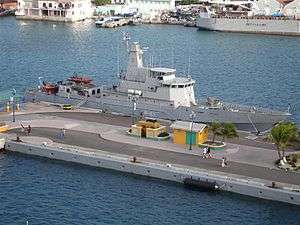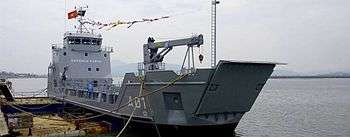Royal Bahamas Defence Force
| Royal Bahamas Defence Force | |
|---|---|
|
Bahamas Defence Force emblem | |
| Founded | 1980 |
| Service branches | Navy, Special Operations Unit, Commando Squadron |
| Headquarters | New Providence Island |
| Leadership | |
| Commander-in-Chief | Queen Elizabeth II |
| Minister of National Security | Marvin Dames |
| Commodore | Tellis Bethel |
| Manpower | |
| Military age | 18 years of age for selection process, 18 years of age is actual serving age (As of 2007) |
| Available for military service | 84, 903[1], age 16–49 (2010 est.) |
| Fit for military service |
62, 779 [1] males, age 16–49 (2010 est.), 63, 954[1] females, age 16–49 (2010 est.) |
| Reaching military age annually |
2,840[1] males (2010 est.), 2, 758[1] females (2010 est.) |
| Expenditures | |
| Percent of GDP | In 2010 the total estimated capital and recurrent expenditure on the RBDF was $48,901,806 of a total Budgetary Expenditure of $1,819,306,320. This represents about 0.7% of GDP. (http://www.bahamas.gov.bs/finance) |
The Royal Bahamas Defence Force (RBDF) is the navy of The Bahamas. Since The Bahamas does not have an army or an air force, its navy composes the entirety of its armed forces. Under The Defence Act, the Royal Bahamas Defence Force has been mandated to defend The Bahamas, protect its territorial integrity, patrol its waters, provide assistance in times of disaster, maintain order in conjunction with the law enforcement agencies of The Bahamas, and carry out any such duties as determined by the National Security Council. The Defence Force is also a member of Caricom's Regional Security Task Force. The task force has seen action in the United Nations mandate in Haiti 1994.
History
By an Act of Parliament, the RBDF became an official entity on 31 March 1980, falling under the Ministry of National Security. The Queen of The Bahamas, Queen Elizabeth II, is Commander-in-Chief of the Defence Force with her ceremonial role exercised by the Governor General of the Bahamas. The Defence Force also has adopted its own system of medals and awards.
The only combat action the RBDF has ever been involved in has been against Cuba. On 10 May 1980, the HMBS Flamingo attempted to arrest two Cuban fishing vessels, the Ferrocem 165 and the Ferrocem 54, for poaching in Bahamian waters. In retaliation, two Cuban MiG-21s invaded Bahamas airspace and fired on the patrol boat. The Cubans sank the ship with their 23 mm cannons, and fired upon Marines in distress in the water.[2] Fenrick Sturrup, Austin Smith, David Tucker and Edward Williams, all Bahamian Defence Force Marines, were killed in the attack.[3] Fifteen crewmen and the Commander made it safely to Duncan Town, on Ragged Island, after being picked up by the fishing vessels they had boarded. The poachers were convicted in July 1980, and Cuba eventually admitted responsibility, paying the Bahamas $10 million in compensation for the incident.
The Force
The RBDF is a strictly naval force, differing from the rest of its Caribbean and British Commonwealth counterparts in there being no regular land-based military formations. With about 1,600 members however, it is the largest of the Commonwealth Caribbean navies.
Serving members of the RBDF are assigned to one of six major sub-sections: Headquarters, Administration, Engineering, Supply, Operations and The Commando Squadron. The Operations Department contains the mobile arms of the RBDF and comprises the main operational units:
- The (Patrol) Squadron - The maritime unit tasked with operating all RBDF ships and small craft of the Harbour Patrol Unit (a security sub-unit)
- The Commando Squadron - An amphibious light-infantry unit, also tasked with additional national security/anti-crime duties
- The Air Wing - Which operates a fleet of fixed-wing aircraft for airborne surveillance and support tasks
The Commando Squadron is a sizable force of 500 Special Marine Commandos. Training is conducted with U.S. Special Operations Forces and British equivalents (such as the Royal Marines) in special operations and maritime warfare. A common training practice is to have a marine recruit conduct a two-mile swim carrying a forty-pound rucksack.
Several changes in equipment have been seen in the recent history of the RBDF. Originally British-style uniforms were worn by RBDF personnel; now U.S. Marine Corps-style digital woodland camouflage is worn (as opposed to the U.S. Army universal camouflage worn by The Royal Bahamas Police Force Drug Enforcement Unit). Similarly, the first weapons employed by the RBDF were the British Sterling submachine gun and the L1A1 SLR; now the U.S.-manufactured M4 carbine and the Heckler & Koch UMP sub machine gun are employed for front-line duties.
The M101 105mm Howitzer towed artillery piece is also employed, with fifteen guns in RBDF service.
Structure

There are two career tracks in the RBDF: Marine (rating) & Officer (ranks). The enlisted personnel ranks range from Marine Seaman to Force Chief Petty Officer. The Officer ranks range from Midshipman to Commodore. The force is organized and trained along the lines of the British Royal Navy and many of the officers attend British service academies.
The Headquarters of the Defence Force are at RBDF Base HMBS Coral Harbour, on New Providence Island. The commander officer, known as "Commander Defence Force" is Commodore Tellis Bethel. Additional bases are located in Matthew Town, Inagua and Freeport, Grand Bahama.
The RBDF uses the British Royal Navy style of rank insignia, and all ships carry the title HMBS (Her Majesty’s Bahamian Ship).
Due to a lack of ships, most RBDF members do not spend time at sea, and are used for other military or non-military roles. The Defence Force is primarily an armed service, whose roles also encompass some aspects of a coast guard as well as a disaster relief agency. These roles require Defence Force personnel to assume the duties of: Naval and infantry personnel, Police Officers (Peace Officer), Customs Officers, Immigration Officers, Fisheries Inspectors, Emergency Rescue Personnel, Search & Rescue, Sentry, Detention Center security and Maintenance of Navigational Aids.
The RBDF offers a cadet program for youth called the Rangers.
Peacekeeping missions have been conducted with the participation of RBDF members in El Salvador and Haiti.
Equipment
- Browning Hi-Power
- Colt 1911 9mm pistol
- Sig Sauer P226 pistol
- Beretta 92FS Pistol
- 9mm IMI Uzi SMG
- 9mm IMI Mini-Uzi SMG
- 9mm Sterling MK-IV\L-2A3 SMG
- 18.5mm 12 gauge SPAS-12 Shotgun
- 18.5mm 12 gauge Remington Model-870P Shotgun
- 7.62mm FN FAL 50-00\ L-1A1 SLR
- 7.62mm Remington 700P
- 5.56mm IMI Galil AR
- 5.56mm Colt M4 Carbine SAR
- 5.56mm Colt M16A-2 & M16A-4 AR
- 5.56mm AR-15R-600 AR
- 7.62mm FN MAG 60-20 LMG
- 15 M101 105mm Towed Howitzer
- Land-Rover 4
Ships
The main ships in the force are two Bahamas-class and four Legend-class offshore patrol vessels.[4] The latter are the first part of the nine-vessel acquisition contract signed with the Damen Shipyards Group in April 2013.[5][6] Most of the missions consist of anti-poaching patrols, anti-drug patrols, immigration enforcement, search and rescue, or general National Defence missions.
Four of the new vessels will be Stan 4207 design, four of the new vessels will be Stan 3007 design, and the final vessel will be 55 metres (180 ft) landing craft style transport craft, Damen type Stan Lander 5612.
| Class | Photo | No. | Ship | Commissioned | Note |
|---|---|---|---|---|---|
| Patrol vessels | |||||
| Bahamas class |
 |
P 60 | Bahamas | 12 January 1999 | Built by Moss Point Marine at Escatawpa, Mississippi |
| P 61 | Nassau | 12 January 1999 | Built by Moss Point Marine at Escatawpa, Mississippi | ||
| Legend class Damen Stan 4207 |
 |
P 421 | Arthur Dion Hanna | 22 June 2014[4] | Built in Netherlands |
| P 422 | Durward Knowles | 31 July 2014[4] | Built in Netherlands | ||
| P 423 | Leon Livingstone Smith | 22 September 2014[7] | Built in Netherlands | ||
| P 424 | Rolly Gray | 30 April 2015[8] | Built in Netherlands | ||
| Damen Stan 3007 |
 |
P 301 | Lignum Vitae | March 2015[9] | Built in Netherlands |
| P 302 | Cascarilla | March 2016[9] | Built in Netherlands | ||
| P 303 | Kamalame | 2016 | Built in Netherlands | ||
| P 304 | Madeira | 2016 | Built in Netherlands | ||
| Damen Stan Lander 5612 |
 |
A01 | Lawrence W. Major | March 2016 [9] | Built in Netherlands |
Air Wing

The Air Wing was formed on November 26, 1981, two years after the creation of the defence force. Initially three Aero Commanders were purchased from Bahamasair and operated, but these were sold off in 1990. In 1992, a Cessna 402 was added with a Cessna 421 soon after. By late 2005, the delivery of a Beech 350 Super king Air took place. In May 2009, a Cessna 208 Turbine Caravan with floats and a Partenavia P68 were delivered and significantly improved the RBDF's surveillance and transport capabilities.
The current fleet of the RBDF Air Wing consists of:
- Cessna 208 - Utility Aircraft
- King Air 350 - Maritime Patrol
- Partenavia P.68 - Maritime Patrol/Utility
References
- 1 2 3 4 5 Bahamas, The. "CIA – The World Factbook". CIA.gov. Retrieved 23 February 2011.
- ↑ Webbe, Stephen (May 19, 1980). "Bahamas seethes over patrol-boat sinking". The Christian Science Monitor. Boston, MA. Retrieved 2013-03-12.
- ↑ Maura, Matt (May 13, 2011). "Prime Minister says country remains 'indebted' to marines of HMBS Flamingo". The Freeport News. Freeport, Bahamas. Retrieved 2013-03-12.
- 1 2 3 Jon Rosamond (2014-07-24). "Bahamas inducts first vessels in fleet renewal effort". London: IHS Jane's Defence Weekly. Archived from the original on 2014-07-27. Retrieved 2017-03-26.
The first of four 42 m Legend-class (Stan Patrol 4207) offshore patrol craft, HMBS Arthur Dion Hanna (P421), was commissioned into service on 20 June, having completed its transatlantic delivery voyage in May, and commenced its maiden operational deployment on 27 June.
- ↑ "Royal Bahamas Defence Force contracts Damen for fleet of long range patrol craft 19 Apr 2013". Damen Group. 2013-04-19. Archived from the original on 2014-07-18.
In addition, eight patrol vessels, four of the Damen Stan Patrol 4207 type and another four type SPa 3007, will join the Bahamas’ fleet.
- ↑ "Lock, Stock and a Sandy Bottom". Think Defence. 2013-05-13. Archived from the original on 2013-08-15. Retrieved 2014-07-18.
- ↑ "Bahamas PM Vows Even Greater Resolve to End Transnational Crime". The Bahamas Weekly. 22 September 2014. Retrieved 13 June 2015.
- ↑ "Hmbs Rolly Gray Commissioned In Exuma". Tribune 242. 30 April 2015. Retrieved 13 June 2015.
- 1 2 3 "Defence Force Bolsters Fleet With Three New Vessels, Mobile Base". Tribune 242. 18 March 2016. Retrieved 18 March 2016.
{{http://rbdf.gov.bs/sandy-bottom-project/}}
External links
- Royal Bahamas Defence Force Official Website
- Sandy Bottom Project
- The Bahama Journal: Commodore Admits “Rotten Apples”
- The Bahama Journal: Defence Force Gets New Chief
- Bahamas Government Website: Royal Bahamas Defence Force
- The Bahama Journal: Bottom Line: Defense Force Re-Organization
- The Nassau Guardian: Commodore to retire
- The Nassau Guardian: Sunk HMBS Flamingo 24th anniversary observed today
